In Africa,
we can find some very dangerous animals like lions hippopotamus, crocodiles and
of course snakes. The African continent has some of the most dangerous and
venomous snakes in the world.
Here
are some interesting and amazing
facts about some of Africa's top 10 most venomous and dangerous
snakes!
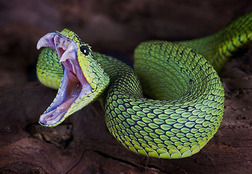
Black Mamba
The Black Mamba (Dendroaspis
polylepis) is Africa's largest venomous snake, reaching an average 2.5 m
in length (8 feet) but can get as long as 4.5 m (14 feet).
It's
extremely aggressive, and will not hesitate to strike, very fast and agile, it
can reach speeds of up to 12mph (20 km/h). In spite of the name the
"black" mamba skin color is not black, it's rather brownish/olive or
brown/grey, the name derives from its black mouth, displayed when it feels
threatened.
Its
venom is an extremely potent neuro and cardio-toxic mix, capable of killing a
dozen men within the hour, without proper treatment and anti-venom, the
mortality rate is almost 100%. It feeds on moles, rats, mice, birds,
squirrels and other small mammals.
Mozambique Spitting Cobra
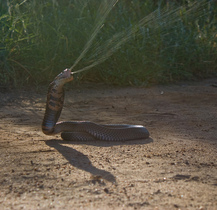

The
Mozambique Spitting Cobra (Naja mossambica)
is probably the most common cobra found in tropical and subtropical Africa. It
is considered one of the most dangerous African venomous snakes, overshadowed
only by the black mamba.
As
the name indicates, the Mozambique Spitting Cobracan
"spit" it's venom. However "spraying" is probably a more
accurate definition. The snake can spit/spray it's neurotoxic venom with great
accuracy at distances up to 3 m long.
Their
bite can cause severe tissue damage, if the venom hits the eyes it will cause
impaired vision or even blindness. When molested, this snake can also
elevate as much as two-thirds of its body. This snake species does
not necessarily bite it may even simulate death to avoid further molestation.
Puff Adder
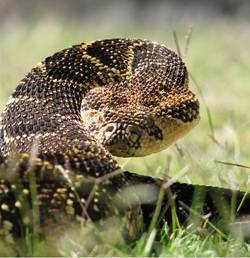
The
Puff Adder (Bitis arietans) is
responsible for more human fatalities than any other snake species in Africa.
The species accounts for some 60% of all snakebites in the continent.
It's
the most common and widespread snake species on the African continent and inhabits the
majority of regions, except for desertic regions and rainforests.
Since
the species relies on camouflage to hide and will lie still when approached,
people tend to step on them and get bitten. They have very long fangs, 12
to 18 mm long, and an
average body length of around 40 inches (1 m).
The Puff Adder moves in a similar fashion to the way
caterpillars move. They are good swimmers and climbers. When disturbed
the species hisses loudly forming a tight coil and then strikes
sideways. In a single bite
it can inject between 100 and 350 mg of cytotoxic venom, the lethal dose for a
human is around 100 mg.
Gaboon Viper
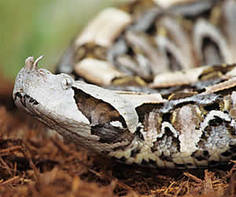
The Gaboon Viper (Bitis
gabonica) blends perfectly in the leaf cover and surrounding vegetation
making it the ultimate ambush predator. It ambushes its prey, large birds, and
some mammals, by standing still and attacking by surprise.
They
are very heavy-bodied snakes that can weigh up to 10 kg and can grow to over 2
m in length. With a large triangular shaped head, the species develops
two nostril horns with age. It possesses the longest fangs of any snake in the
world, up to 2 inches (record at 50 mm).
Egyptian Cobra
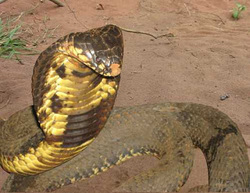
Despite
what its common name would suggest, Egypt is not the only habitat for the
Egyptian Cobra (Naja haje). The
species is commonly found in Egypt, but in fact is the most widespread of the
African cobras.
Their
average size is between 1.5 to 2 m, though some specimens can exceed 2.5 m (8
feet) in length.
The Egyptian Cobra venom is considered the
3rd most toxic venom of any cobra species, just after the Northern Philippine
Cobra and Cape Cobra. In fact, its venom is so potent it can kill an adult
elephant in just under 3 hours, and a human in 15 minutes.
As
the legend goes Cleopatra is believed to have committed suicide using an
Egyptian Cobra.
Saw-Scaled Viper
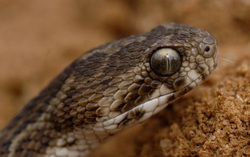
Found
north of the African Equator, the Saw-Scaled Vipers (Echis carinatus) are small yet viciously aggressive and easily
excitable temperament snakes.
The
average adult vipers reach a length of around 20 to 30 inches. There are 5
subspecies currently recognized. It's the smallest member of the Big Four Indian snakes which
are responsible for the most snakebites and deaths in India.
The
species gets its name from the "sizzling" sound it makes as it rubs
its scales, and serves as a warning. The snake's venom is haemotoxic and very
potent, according to some researchers, the venom is 5 times more toxic than
that of the indian cobra, and 16 times more toxic than the Russell's Viper.
Boomslang
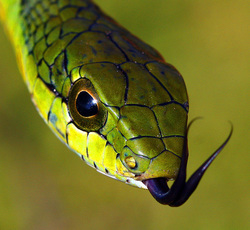
The Boomslang (Dispholidus typus)
is found in sub-Saharan Africa and is considered the most venomous rear-fanged
snake in the world.
The
name "Boomslang" comes from the Afrikaans word "tree
snake", it's a "tree-dwelling" snake species. Much like the
Gaboon Viper, the Boomslang fangs are very long, and it can open
its mouth at a full 180 degrees to bite.
While
fatalities caused by the species are rare since it is very
timid, this snake venom is haemotoxic and
results in internal and external bleeding. The sexual dimorphism is
particularly apparent in the Boomslang as females are brown, whereas males are
light green with some black highlights.
Cape Cobra
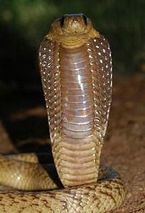
The Cape Cobra (Naja nivea)
highly neurotoxic venom is thought to be the most potent of all African cobras.
It's sometimes also called the yellow cobra.
These
are beautiful snakes that vary both in color ranging from yellow to
copper/mahogany colored and purplish/black and size with an average of 4 feet
but can grow to 6 feet.
The
mortality rate in humans is more or less around 60% if not treated immediately.
Death usually occurs between 2 and 5 hours after the bite and is
commonly the result of respiratory failure due to paralysis.
Green Mamba
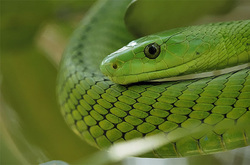
The
Green Mamba venom composition is similar to that of its cousin the infamous
black mamba. But it's only about one-tenth as toxic. The species as the
name implies differs in colour with a glossy grass-green and an average size
about 15.9 feet (1.8m).
It
is also very shy and much less aggressive than the black mamba, and tends to be
more arboreal instead of mainly terrestrial. There are two species of
green mamba, the Western Green Mamba (Dendroaspis
viridis) which is native to West Africa, and the Eastern Green Mamba (Dendroaspis angusticeps) found on the eastern
side of southern Africa.
Bush Viper

The
Bush Viper (Atheris squamigera), is
sometimes also called the Leaf Viper or green bush viper, is an arboreal snake
that dwells the rain-forests and woodlands habitats of Africa in
Congo Basin, Uganda, Kenya.
Is
highly venomous but relatively passive even so it will defend itself when
molested. Its habits are primarily nocturnal and often comes to the ground to
feed on small rodents, frogs, and lizards.
Using
its tail to hang from the lower branches of trees and strikes on its
unsuspecting prey. Their colour is usually green but will adapt to its
environment for survival so specimens that are olive brown or rusty brown
colour are common.